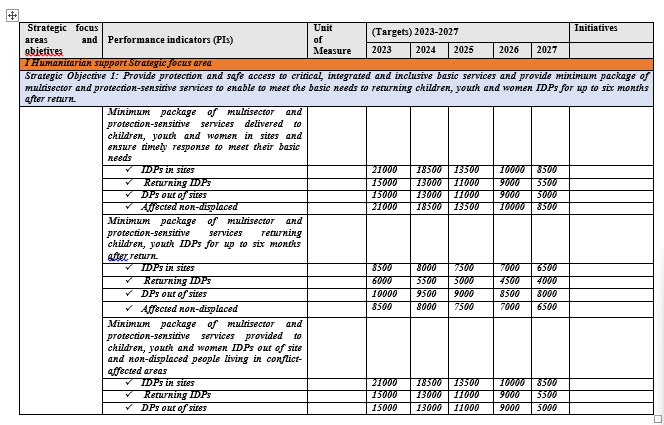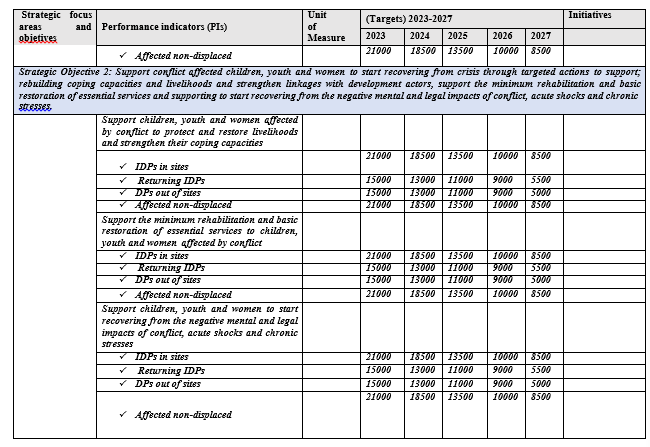May 1, 2023
HEAL OUR PEOPLE
Mengesha building Near Atse Yohannes Hotel Adhanet Kebelle Kedamy woyane Subcity Mekelle, Tigray, Ethiopia
Acronyms
ACSO Authority for Civil Society Organizations CCCM Camp Coordination and Camp Management CERF Central Emergency Response Fund
COVID 19 Cornea Virus December 19 CSO Civil Society Organizations
DDR Disarmament, Demobilization and Reintegration ED Executive Director
ESNFI Emergency Shelter and Non-Food Items FDRE Federal Democratic Republic of Ethiopia GBV Gender Based Violence
GDP Gross Domestic product
GTP Growth and Transformation Plan
HEW Health Extension Workers
HIV Human immunodeficiency Virus
HOP Heal Our People
HRM Human Resource Management
HSTP Health Sector Transformation Plan
IDP Internally Displaced People
ILO International Labor Organization
IOM International Organization for Migration
JD Job Description
MDG Millennium Development Goals
MEAL Monitoring and Evaluation Accountability and Learning MEP Monitoring and Evaluation Plan
MR Mandatory Reporting
NFI Non Food Items
NGO Non-Governmental Organization
OCAT Organizational Capacity Assessment Tool OCHA Office for Coordination of Humanitarian Affairs PSEA Prevention of Sexual Abuse and Exploitation PSS Psycho-Social Support
RRF Rapid Response Fund
SDG Sustainable development Goals
SEA Sexual Exploitation and Abuse
ToR Terms of Reference
TPLF Tigray People’s Liberation Front
UNESCO United Nations Education Scientific and Cultural Organization USAID United States Agency International Development
WASH Water Sanitation Hygiene WGSS Women’s’ and Girls’ Safe Space
Table of Content
Acronyms……………………………………………………………………………………………………………………….. 1
- Background of HOP…………………………………………………………………………………………………….. 3
- Introduction………………………………………………………………………………………………………………… 5
- Context Analysis…………………………………………………………………………………………………………. 7
- Theory of Change………………………………………………………………………………………………………… 9
- The strategy………………………………………………………………………………………………………………. 11
- HOP Strategic Themes……………………………………………………………………………………………….. 12
- Humanitarian support………………………………………………. Error! Bookmark not defined.
- Livelihood Strategic focus area…………………………………. Error! Bookmark not defined.
- Targets……………………………………………………………………………………………………………………… 15
- Strategy Implementation…………………………………………………………………………………………….. 22
- Monitoring, Evaluation, Accountability and Learning (MEAL)………………………………………. 26
Annex -HOP organizational Structure 27
1. Background of HOP
Heal Our People (HOP) is a board led national Civil Society Organization (CSO) founded in February, 2021. HOP was first registered and awarded a certificate from Tigray Bureau of Justice; preceded by another registration and a certificate it received from federal Agency of Civil Society Organizations (ACSO) on March, 2021 to work as charitable organization. Currently, HOP has been registered and accorded legal personality with registry Number of 6696 on February 27, 2023 as a Local Organization in accordance with the Civil Society Organizations proclamation No1113/2019.
HOP is mandated to coordinate support mapping, mobilize and soliciting resources, and use it for eradicating socio-economic problems in Ethiopia by empowering vulnerable children, youth, and women through comprehensive education, health, and development programs.
The war erupted in Tigray resulted in death tall and displacements of civilians, loss of property and infrastructure damages, extensive perpetration of GBV, psychosocial trauma stemming from insecurity, tensions and anxiety, loss of livelihood and demolition development programs, collapse of socioeconomic activities. Following the war, HOP starts to operate its activities in humanitarian emergence.
Despite all the impediments placed on the path of its operation, HOP has been engaged in Camp Coordination and Camp management (CCCM) project in 3 sites of Mekelle and Adigrat. Accordingly, HOP’s CCCM projects are benefitted for 30,243 IDPs with protection and lifesaving assistances. CCCM projects are also underway in Abyi-Ady and Wukro benefiting 9,829 IDPs. HOP pioneered the use of unfinished private building at Mekelle to hosting 455 IDP households through negotiating with building owners and making it habitable through augmentation of toilets, showers and handwashing facilities. Since then and until now the settlement site is called HOP IDP camp. Through a project on repair of damaged community residential houses, HOP benefited 284 households in terms of the distribution of house repair materials and repair kits in Hawzen wereda, Tigray.
HOP has also distributed Non-Food Items (NFI) to 1,250 households, provided emergency food assistance to 32 separated and unaccompanied children, served a lunch to 1,100 IDPs in holiday
celebration as part of HOP’s core works. Furthermore, HOP delivered Women and Girl’s Safe Space (WGSS), Psychosocial Support (PSS) counselling and livelihood support to 200 Gender Based violence (GBV) survivors and supplied sanitary supplies to GBV survivors besides referring GBV survivors for medical, psychosocial and legal services.
As a result, since its establishment HOP has been experienced in manging and implementing the following projects:
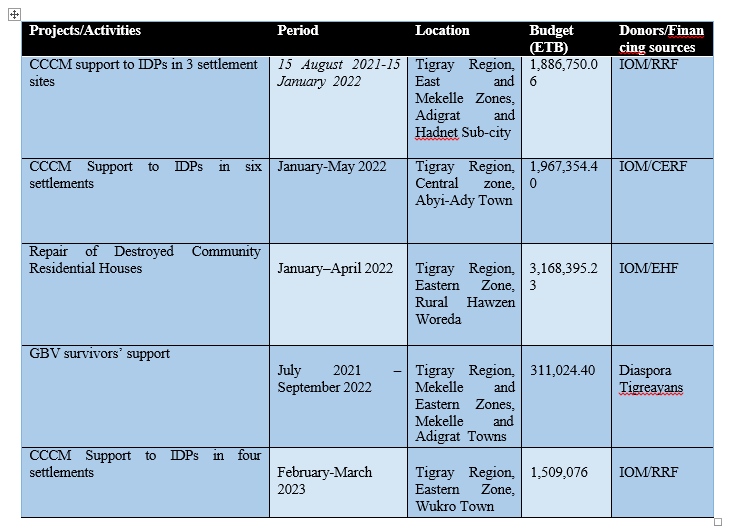
Considering HOP’s year of establishment, and the context of funding for local civil society organizations where localization of funding atmosphere was limited, HOP’s participation in humanitarian emergency response was encouraged. Even if limited funding opportunities have been available to CSOs, HOP was experienced with better sub-grantees truck record in implementing different projects mentioned above. Therefore, the experience and knowledge
HOP developed in project management and project implementation may help us in successfully implementing the strategic plan.
1. Introduction
A long-standing political disagreement between Ethiopia Federal government and the regional government of Tigray led to an outbreak of hostilities on 4th November 2020. This was characterized by military actions resulting in atmosphere of insecurity in the region, internal and external displacements, and a disruption of livelihoods.
More than 20 million people in Ethiopia of which 5.2 million people in Tigray were in need of aid due to the conflict that started at the end of 2020. Tigray has been under a de facto blockade for about two years, with little to no access to cash, fuel, telecommunication, or electricity, limiting humanitarian assistance and the delivery of essential supplies.
The conflict has left many injured and has had a severe impact on families’ lives and livelihoods. The periodic spillover of the conflict into the neighboring regions of Afar and Amhara has significantly increased humanitarian needs in the northern part of the country.
The food security and malnutrition situation has worsened with over 13 million people in need of assistance in Tigray, Amhara and Afar. Disease outbreaks are on the rise, including of malaria, measles, acute respiratory tract infections and other vaccine-preventable diseases while risk of other outbreaks, such as cholera, is high. Over 2.8 million people have been displaced and are living in crowded settings with limited access to food, nutrition, health and water and sanitation infrastructure.
This situation has led to the effective collapse of education and healthcare capacities in Tigray. With no immunization services running, only one in 10 children at one year of age has protection against vaccine preventable diseases that can kill. The conflict has decimated maternal health services, with high maternal mortality rates across the region. Shortages of medication prevent the adequate follow up of HIV and diabetes cases. The deterioration of effective infection prevention and control capacities in healthcare centers is further increasing risks.
Only 3% of health facilities in Tigray were fully functioning. This means most health facilities are unable to meet the standards and health needs of the people. Health workers are running out
of supplies leading to reduced treatment for non-communicable diseases, maternal and child health services, more complications, and more deaths.
The education sector has also stopped its teaching activities for the last three years. Students are being stayed at home without education and teachers are stopped their job. Education materials are also burned, damaged and looted.
The historical agreement for lasting peace through a permanent cessation of hostilities between the government of the Federal Democratic Republic of Ethiopia and the Tigray People’s Liberation Front (TPLF) on 2nd November 2022 altered the entire regional context through creating agreement between the conflicting parties. The agreement creates hope to the people as its objectives includes principles underlying the permanent cessations of hostilities, protection of civilians, humanitarian access, Disarmament, Demobilization and Reintegration (DDR), confidence building measures, restoration of federal authorities and representation in federal institutions, and transitional measures.
While the mechanism is under implementation through the commitment of both parties, some progresses are being achieved with the accomplishment of some of the terms while the others are yet to be assessed in the upcoming future. However, the peace agreement has thus far been seen to bring about tangible results in terms of instilling security, peace and stability in Tigray and making possible the opening of access to telecom, internet, electric, banking, air transport and other services to Tigray. The flow of constant and unrestricted access to humanitarian support to Tigray, the establishment and functioning of the interim Government of Tigray, the withdrawal of Eritrean forces from the occupation of Tigrayan territories, the DDR of TPLF ex-combatants, the return of IDPs in Tigray to their places of origin, the restoration damaged socioeconomic infrastructures back to production and service provision and the ongoing efforts to implement transitional justice in Ethiopia.
The peace agreement offered HOP an opportunity to make strategic redirection from engagements in emergency response operations to early recovery, rehabilitation and development interventions; from collective center based humanitarian support intervention to community based ones, from spontaneous to focused and structured intervention in terms of thematic area and beneficiaries, from small and short-term projects to larger and multiyear programs in terms of scale, from a single donor projects to diverse projects, from sub-grant to grant projects, from narrow geographical areas to expanded ones. In pursuit of meeting its
aspirations, strategic goals and objectives, HOP restated its newly aligned vision, mission and values, invested in defining its thematic areas to be decided by the Management Committee to be Humanitarian Support, Education and Training, Health and Nutrition, and Livelihood and HOP’s target group identified to be Children, Youth and Women as they are the most vulnerable social groups.
HOP conducted Organizational Capacity Assessment Tool (OCAT) which assisted it assess the critical elements for its effective organizational management, and identify areas that need strengthening or further development. This assessment helped us to develop concrete action plans to provide HOP with a clear organizational development roadmap. Finally, HOP developed an organizational structure that defines the vertical and horizontal relationship among every operational departments that will exist in HOP’s operation and more inclusive one to include organizational units that are likely to exist elsewhere in Tigray, Addis Ababa Liaison office, Somalia, Gambelia and Afar.
2. Context Analysis
In order to identify critical issues that this strategic plan needs to deal with formulation of HOP’s future strategic directions, the strategic planning team has been engaged in analyzing HOP’s external and internal environment. Situational analysis is conducted internally by analyzing HOP’s strengths and weakness. Externally, by analyzing HOP’s external opportunities and Threats. We call this SWOT Analysis. Furthermore, macro environment analysis where the political, economic, social, technological, legal and environmental issues are also analyzed and interpreted. We call this PESTLE analysis. Therefore, scanning the environment using the SWOT and PESTLE analysis finally resulted in the following matrix. The matrix helps in identifying future strategic directions by maximize our strengths and opportunities and minimize our weaknesses and threats.
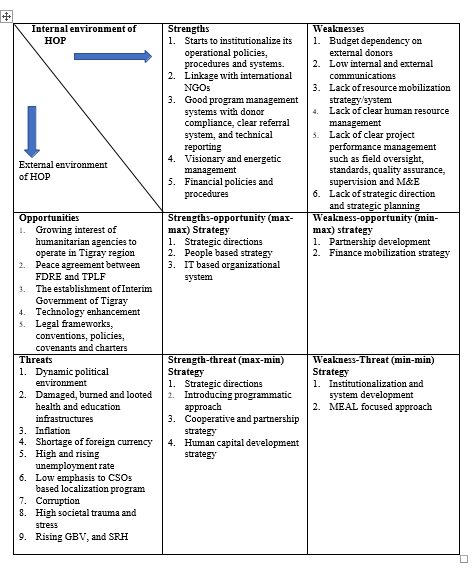
1. Theory of Change
An organization’s Theory of Change describes how it believes it makes a difference and it is a logical sequence of steps expected to lead to a desired outcome. It is also a way of thinking about and planning for change. Therefore, HOP’s theory of change describes how HOP’s strategic plan is approached and implemented. HOP’s theory of change is focused on how our target beneficiaries the children, youth and women are benefited from our programs of humanitarian support, education and training, health and nutrition and livelihood and consequently addresses their socioeconomic problems.
HOP believe that potential problems of the children, youth and women are addressed when partnership and development strategy, HOP’s program of humanitarian support, education and training, health and nutrition and livelihood and HOP’s institution building is implemented in a comprehensive and integrated manner.
It is hard to address the socioeconomic problems of the children, youth and women by HOP’s initiative alone. Rather, it is based on all rounded networks, partnerships, and collaborations required among existing and potential partners. Our partnership will be with state and non-state- based, and local and international organizations. This partnership development program is helpful to mobilize human and financial resources. We also believe that our partnership strategy is build on the bases of trust and respect among partner organizations.
In addition to this our programs are initiated to address the main problems of children, youth and women. Therefore, implementing the humanitarian support, education and training, health and nutrition, and livelihood programs will address the socioeconomic problems of our target group. Thus, we adopt a programmatic approach to implement our strategic objectives and address the socioeconomic problems of the society.
Finally, addressing socioeconomic problems of the children, youth and women requires institutionalized organizations. We believe that HOP’s strategic objectives are implemented when we operate our day-to-day activities as institution. As a result, our focus towards institutionalization is based on. First, developing HOP’s operating policies and procedures and implementing them indiscriminately. Second, institutionalize norms and values that are familiar and convenient to the needs of children, youth and women. Third, at HOP we believe that our vision is our brand and our day-to-day activities considers our vision.
Therefore, our theory of change is based on the input, process and output/outcome/impact model. As a result, socioeconomic problems of the children, youth and women will be solved when the processes at HOP are based on partnership development, institution building and based on programmatic approach.
Figure: HOP’s Theory of Change
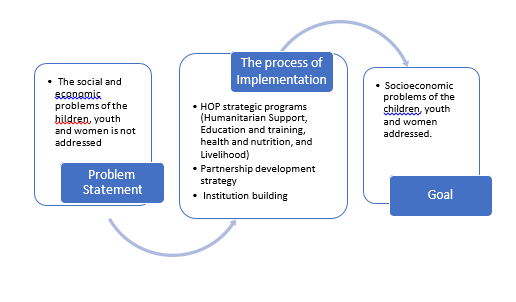
1. The strategy
1.1Vision, Mission and Values
1.1.1 Vision
HOP envisions eradicating the socioeconomic problems facing Ethiopia.
1.1.2 Mission
Heal Our People (HOP) envision eradicating socio-economic problems in Ethiopia by empowering vulnerable children, youth, and women through comprehensive education, health, and development programs. Our mission is to support these populations by providing access to quality education and training, essential health and nutrition services, and promoting women empowerment and gender equality. We strive to create sustainable and inclusive development that uplifts communities and fosters resilience.
1.1.3 Core Value
Humanity: HOP, shares the conviction that all human beings are born free and equal in dignity and rights and affirms the primacy of humanitarian imperative
Impartiality: HOP’s commitment to the provision of humanitarian assistances and services solely on the basis of need and in proportion to the needs of the children, youth and women
Non-discrimination: HOP will work based on the principle that no one should be discriminated against on any grounds of status, including age, gender, race, colour, ethnicity, sexual orientation, language, religion, disability, health status, political or other opinion, national or social origin
Right to protection and security: We believe that safety and security of people in situations of disaster or conflict are our particular humanitarian concern and our assistance will be particularly geared towards those vulnerable to abuse and adverse discrimination.
Trust and Respect: We believe that our relationship with partners and beneficiaries is based on trustfulness and respect.
People Centeredness: Our work with partners/beneficiaries is about people working with people.
Integrity: At HOP we believe in acting with integrity: being truthful in all of our activities, being honest and respectful to all whom we deal with, and having and following strong moral principles
Equity and Equality: HOP cannot achieve good quality in its work if underlying problems of inequity are not addressed. The good quality of our results has a positive effect on capacity development of partners and beneficiaries and indirectly on poverty alleviation. Equity has to do with the core of HOP’s goal of reducing child abuse and gender based violence.
Transparency and accountability: At HOP we strive for transparency and accountability in our daily work and actions. The manner in which HOP runs business is open and transparent. The results of our business practices, both good and bad, our successes, failures, problems and victories all are communicated to relevant internal and external stakeholders. We take responsibility for our work.
2. HOP Strategic Themes
To achieve HOP’s vision and mission, we adopt a programmatic approach which are thematized under the following strategic focus area.
- Women Empowerment
- Education and training
- Health and nutrition
- Gender Equality
2.1 Women Empowerment
The current situation for women and girls in Tigray is extremely challenging due to the conflict and humanitarian crisis. They face significant risks, including widespread sexual and gender-based violence, displacement, and limited access to essential services such as healthcare, education, and nutrition. Many health facilities have been damaged or destroyed, severely limiting access to maternal and reproductive health services. Additionally, the disruption of livelihoods has exacerbated food insecurity, making it difficult for women and girls to meet their basic needs.
Despite these challenges, HOP is working to provide support and protection. Efforts include the establishment of safe spaces, provision of psychosocial support, and distribution of dignity kits to help women and girls maintain hygiene and dignity. There are also initiatives aimed at improving access to education and vocational training, empowering women and girls to rebuild their lives and communities. However, the ongoing conflict and insecurity continue to pose significant obstacles to these efforts.
Strategic Objective 1. Enhance Access to Education and Vocational Training: This objective focuses on increasing opportunities for women and girls to receive quality education and vocational training. By improving access to these resources, women can gain the skills and knowledge necessary to participate fully in the economy, secure better employment opportunities, and achieve financial independence. This includes initiatives such as scholarships, mentorship programs, and the establishment of vocational training centers.
Strategic Objective 2. Strengthen Legal and Social Protections: This objective aims to ensure that women and girls are protected from violence, discrimination, and exploitation. It involves advocating for stronger legal frameworks and enforcement mechanisms to safeguard women’s rights, as well as providing support services such as legal aid, counseling, and safe shelters. Additionally, it includes efforts to raise awareness and change societal attitudes towards gender equality, promoting a culture of respect and inclusion.
.
2.2Education and Training
Due to the conflict the educational workforce in Tigray suffered from trauma, physical injuries, psychological disorder and looting of possessions. These challenges worsened the life of school community and impacted the effort of school reopening and the right of children to access quality education. The loss of life from the education sector due to the war has been 2,146 school community members constituted by 318 male and 1798 female people. Damage of buildings and supplies is the other detrimental legacy of the war in Tigray. It has been found out that out of the total 2,054 schools assessed, 1813 schools encountered either partial (1238) or complete (575) damage of buildings and this makes the percentage of damage 88.27. The figure for damage of school facilities is also very well documented.
Bringing the education sector into the prewar situation requires immense resources and seeks the participation of all the stakeholders of education sector. HOP will contribute its part in improving the situation of education sector via the implementation of the following strategic objective.
Strategic objective 1: Support the effectiveness and efficiency of educational workforce at work through the provision of psychosocial rehabilitation support that enables the workforce to cope with the trauma and psychosocial disorder it has encountered due to the conflict
Strategic Objective 2: Improve access and quality of general education by recreating safe learning environment to school going children, youth and women through repair of school buildings and supply of school materials necessary for their operation.
2.3 Health and Nutrition:
Before the war, Tigray had three tiers of health system: primary healthcare unit which includes health posts, health centers and primary hospitals; secondary care provided by general hospitals; and tertiary care served by specialized referral hospitals. There were two specialized hospitals, 16 general hospitals, 29 primary hospitals, 233 health centers and 712 health posts in the region. A health post, staffed by two community health extension workers (HEWs) implementing the health extension programme (HEP), is the lowest health institution structure in the rural areas and is designed to serve one kebele (the smallest administrative unit in Ethiopia). Five Kebeles (five health posts) form a catchment area for a health center catering to 15000–25000 rural or 40000 urban populations.
However, health sector in Tigray is one of the most affected sectors by the war. Healthcare facilities in Tigray are taken as a potential weapon of war with destruction and looting has led to displacement of thousands of healthcare workers including death of workers. Following the war, the healthcare financing programme (including community-based health insurance) has collapsed completely, and people cannot afford to pay for medical services even when there is access to medical care. The health information system has totally collapsed across the region as majority of the tools such as computers and hard-copy medical records are looted or destroyed. Health facilities, laboratory materials and building facilities are burned, damaged, and looted.
HOP plans to support the recovery of the regional health service delivery system through implementation of the strategic objective stipulated hereunder.
Strategic Objective 1. Increase the availability and accessibility of comprehensive sexual and reproductive health (SRH) services, including family planning, HIV/AIDS prevention, and maternal health care, particularly in underserved and rural areas.
Strategic Objective 2. Enhance the capacity of health facilities, law enforcement, and social services to provide comprehensive and survivor-centered responses to GBV. And reduce the incidence of GBV through community-based prevention initiatives that address the root causes and promote gender equality.
institutions’ buildings and supply of medical materials necessary for resumption of the health facilities’ operation.
2.4 Gender Equality
The current situation of gender equality in Tigray is deeply concerning due to the ongoing conflict and humanitarian crisis. Women and girls face significant challenges, including widespread sexual and gender-based violence, displacement, and limited access to essential services such as healthcare, education, and nutrition. Many health facilities have been damaged or destroyed, severely limiting access to maternal and reproductive health services. Additionally, the disruption of livelihoods has exacerbated food insecurity, making it difficult for women and girls to meet their basic needs. The conflict has also led to significant psychological distress among women, exacerbated by malnutrition and displacement.
Despite these challenges, various humanitarian organizations are working tirelessly to provide support and protection. Efforts include the establishment of safe spaces, provision of psychosocial support, and distribution of dignity kits to help women and girls maintain hygiene and dignity. There are also initiatives aimed at improving access to education and vocational training, empowering women and girls to rebuild their lives and communities. However, the ongoing conflict and insecurity continue to pose significant obstacles to these efforts.
Strategic Objective 1. Promote Equal Access to Education and Employment Opportunities: This objective aims to ensure that women and girls have the same opportunities as men and boys to access quality education and secure meaningful employment. This includes initiatives to eliminate barriers to education, such as providing scholarships, creating safe learning environments, and promoting STEM education for girls. Additionally, it involves advocating for equal pay, supporting women in leadership roles, and creating policies that encourage work-life balance and prevent workplace discrimination.
Strategic Objective 2. Strengthen Legal Frameworks and Enforcement Mechanisms: This objective focuses on enhancing the legal protections for women and girls to ensure their rights are upheld and respected. It involves advocating for the implementation and enforcement of laws that protect against gender-based violence, discrimination, and exploitation. This also includes providing legal aid and support services to survivors of violence, raising awareness about women’s rights, and promoting gender-sensitive policies and practices within institutions and communities.
.
3. Targets
Identification of measurable indicators and physical targeting in this strategic plan is carried out based on the consideration that,
- HOP has so far been involved in humanitarian support activities and will use the achievements thus far as a baseline to future interventions.
- Majority of the interventions in the humanitarian support strategic focus areas will be implemented in Eastern, Central and Northwestern Tigray where humanitarian support needs are high and security situations are, at the same time, improving. Intervention in Western Tigray will depend on security situation.
- Interventions in the education and health sector will entail huge implementation costs. The mobilization costs are also high. To ensure cost effectiveness, implementation of projects will consider nearer geographical at Southern, Southeastern and Eastern Tigray.
- Specific project locations, the standard quantity of material support to schools and health institutions will be identified in close consultation with Tigray Bureau of Education and Tigray Bureau of Health
- HOP’s emerging institutional capacity, shrinking global and national funding opportunities and other factors constrained the level of targeting visa vis the gravity of people’s needs in Tigray
